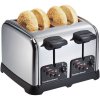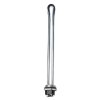This is a review and detailed measurements of the Neurochrome HP-LOAD "dummy load." It was kindly donated to me by its designer, and our valued member, @tomchr. It costs US $1,499 from him direct.
I don't know why but for some reason, companies sell you instruments for tens of thousands of dollars to measure audio devices but they don't sell a necessary dummy load. A dummy load is what simulates a headphone or speaker so that we can have a consistent target to use and compare. I guess they assume if you are going to measure audio, you know how to build one. That is true but building a high performance dummy load is not easy. The load itself can contribute distortion and noise to the device being tested.
A year ago Tom approached me and asked if I was interested in a properly built dummy load for headphone amplifier testing. I said yes as like him, I had cobbled together my own and was not happy with it. I actually used three different ones which I used for different circumstances. He went to work and sometime later sent me a box. I must confess, I expected to see a hobby box and instead, I received this work of beauty:

Wow! Power it on and the LEDs light up and you can push a nice feeling button to cycle between them. You can not only control the load resistance but also capacitance. Two cables, one for balanced and another for unbalanced, connect to that DB-9 socket and provide proper Kelvin-type measurements.
Looking at the back, you see a very nice automation interface:

Audio Precision has an AUX bus that you can control through automation. This port is compatible with that so you automate testing of the amplifier across the full set of loads with just one click of the mouse! I am not yet using this but should do to save some work.
As you see, power is provided by a switching power supply. I should note that in one or two cases, I somehow created a ground loop that did not exist in my simpler setup. Disconnecting the power supply solved that as the load continues to represent the default impedance even when powered off. I could never replicate this problem and it has not happened for a long time.
Back to the box, all measurements interface with Audio Precision using balanced differential output whether the headphone amp is being tested in balanced or not. So you get noise immunity that way.
As nice as the outside is, the inside is even nicer:

All load resistors are head sink mounted and are the nice high quality ones from Caddock. These things are not cheap. Add them up and all the relays in there and such and the cost travels to hundreds of dollars. And this is for parts alone.
Dummy Load Measurements
Audio Precision APx555 has its own internal loads. Because they eliminate all wiring and are of high quality, for 300 ohm testing I have been using it. I always worried about damaging them though as they have limited power capability. Let's compare that load to HP-Load using Topping A90 as the test platform:

As you see, I can measure down to SINAD of 120 dB with zero deviation from APx555.
I have not found a use for the reactive load setting. Here are the two extremes:
[graph should say 10 nf, not 10 uf]:

Will have to find an amp that misbehaves to use this feature.
I should note that you have been seeing the results of this load box for a while. Anytime you see a graph like this:

It is produced using HP-LOAD box.
Conclusions
If you are doing any high performance headphone amplifier measurements, you need a high quality dummy load. A poor one can introduce its own noise and distortion which ruins the reliability of your measurements. If you are a company producing headphone amps, you need to get the HP-LOAD box. It will help standardized our measurements so that we can better compare them with each other. Furthermore, the automation will allow you to speed up your testing and breadth of what you check in production or engineering phases.
I am happy to give a strong recommendation to Neurochrome HP-LOAD. Puts a smile on my face very time I use it!
-----------
As always, questions, comments, recommendations, etc. are welcome.
Any donations are much appreciated using: https://www.audiosciencereview.com/forum/index.php?threads/how-to-support-audio-science-review.8150/
I don't know why but for some reason, companies sell you instruments for tens of thousands of dollars to measure audio devices but they don't sell a necessary dummy load. A dummy load is what simulates a headphone or speaker so that we can have a consistent target to use and compare. I guess they assume if you are going to measure audio, you know how to build one. That is true but building a high performance dummy load is not easy. The load itself can contribute distortion and noise to the device being tested.
A year ago Tom approached me and asked if I was interested in a properly built dummy load for headphone amplifier testing. I said yes as like him, I had cobbled together my own and was not happy with it. I actually used three different ones which I used for different circumstances. He went to work and sometime later sent me a box. I must confess, I expected to see a hobby box and instead, I received this work of beauty:
Wow! Power it on and the LEDs light up and you can push a nice feeling button to cycle between them. You can not only control the load resistance but also capacitance. Two cables, one for balanced and another for unbalanced, connect to that DB-9 socket and provide proper Kelvin-type measurements.
Looking at the back, you see a very nice automation interface:
Audio Precision has an AUX bus that you can control through automation. This port is compatible with that so you automate testing of the amplifier across the full set of loads with just one click of the mouse! I am not yet using this but should do to save some work.
As you see, power is provided by a switching power supply. I should note that in one or two cases, I somehow created a ground loop that did not exist in my simpler setup. Disconnecting the power supply solved that as the load continues to represent the default impedance even when powered off. I could never replicate this problem and it has not happened for a long time.
Back to the box, all measurements interface with Audio Precision using balanced differential output whether the headphone amp is being tested in balanced or not. So you get noise immunity that way.
As nice as the outside is, the inside is even nicer:

All load resistors are head sink mounted and are the nice high quality ones from Caddock. These things are not cheap. Add them up and all the relays in there and such and the cost travels to hundreds of dollars. And this is for parts alone.
Dummy Load Measurements
Audio Precision APx555 has its own internal loads. Because they eliminate all wiring and are of high quality, for 300 ohm testing I have been using it. I always worried about damaging them though as they have limited power capability. Let's compare that load to HP-Load using Topping A90 as the test platform:
As you see, I can measure down to SINAD of 120 dB with zero deviation from APx555.
I have not found a use for the reactive load setting. Here are the two extremes:
[graph should say 10 nf, not 10 uf]:
Will have to find an amp that misbehaves to use this feature.
I should note that you have been seeing the results of this load box for a while. Anytime you see a graph like this:
It is produced using HP-LOAD box.
Conclusions
If you are doing any high performance headphone amplifier measurements, you need a high quality dummy load. A poor one can introduce its own noise and distortion which ruins the reliability of your measurements. If you are a company producing headphone amps, you need to get the HP-LOAD box. It will help standardized our measurements so that we can better compare them with each other. Furthermore, the automation will allow you to speed up your testing and breadth of what you check in production or engineering phases.
I am happy to give a strong recommendation to Neurochrome HP-LOAD. Puts a smile on my face very time I use it!
-----------
As always, questions, comments, recommendations, etc. are welcome.
Any donations are much appreciated using: https://www.audiosciencereview.com/forum/index.php?threads/how-to-support-audio-science-review.8150/
Last edited:

